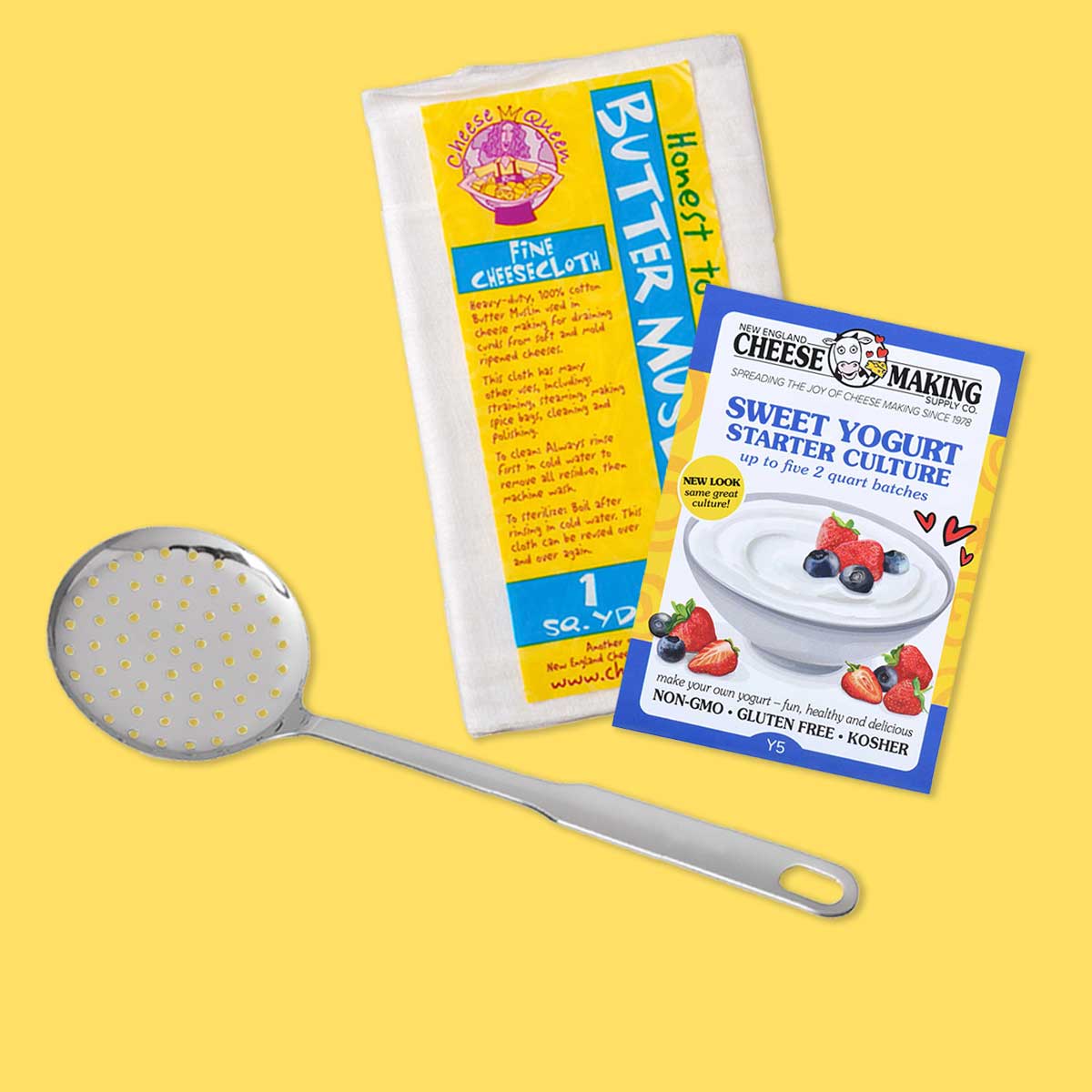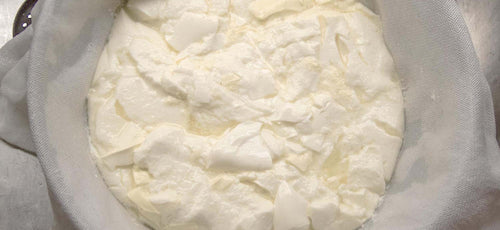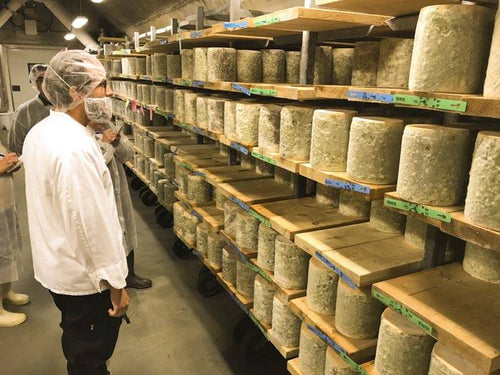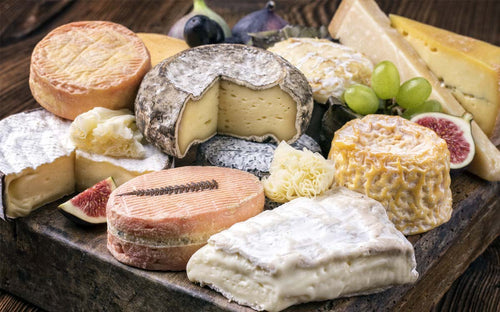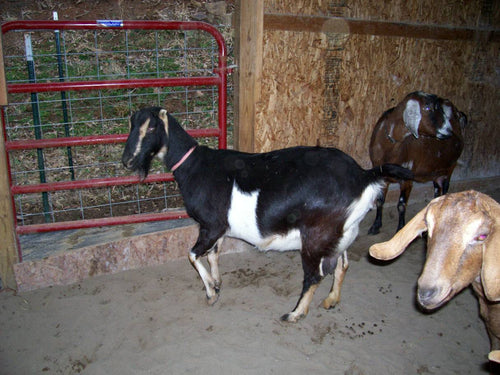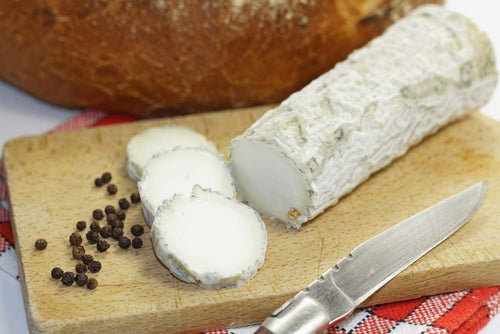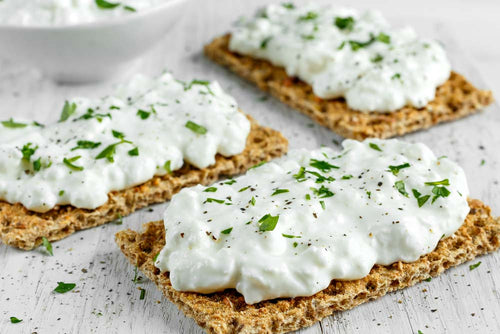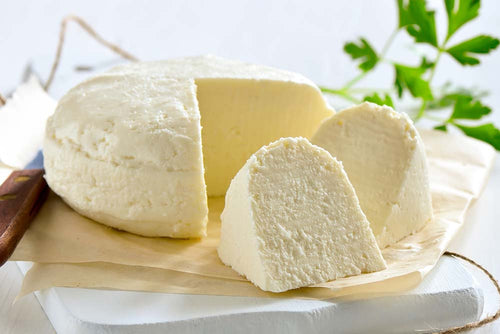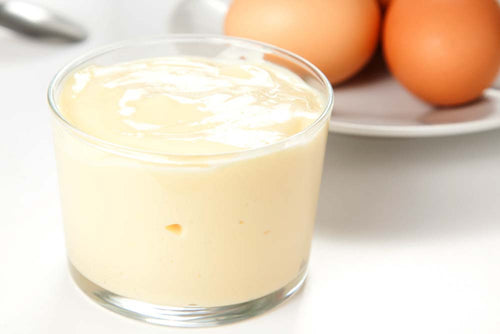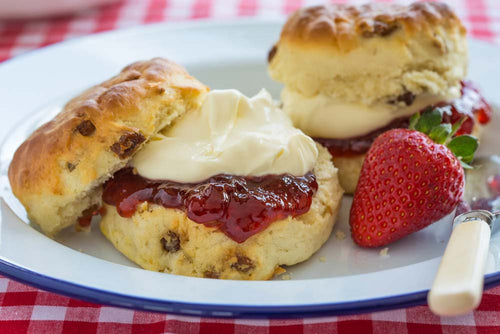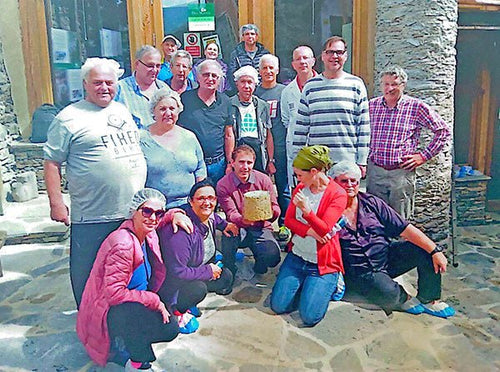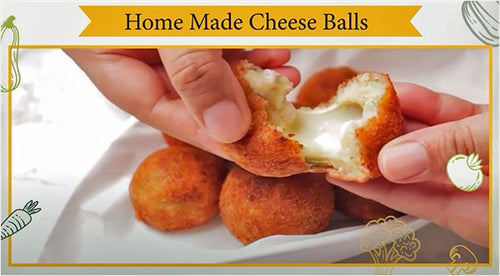Cheese Making Recipe of the Month
Shropshire Blue
This is a fabulous cheese for intermediate to advanced cheese makers. It's a lovely cross between a flaky and acid Cheshire Cheese and a Stilton.
As usual, Jim's recipe is as detailed as you will find anywhere in print. There are pictures and comments for every step along the whey. He even tells you the total time involved in making this cheese, so you can start it early enough in the morning.
Have you made it yet?!
Meet Some Fellow Cheese Makers
Sister Gertrude with Simon, a Great Dane
Sister Gertrude Read
Virginia Dale, Colorado
Sister Gertrude was one of the entrants in our 35th Anniversary Essay Contest last December. She lives at the Abbey of St. Walburga, a beautiful place with a spectacular view of the mountains. She and the other women there raise cattle and sell the beef to support the Abbey.
A couple of years ago, Sister Gertrude was asked if she might be interested in learning to make cheese because there was plenty of milk from the cows. She was and she did! Now, she loves it.
Sister Gertrude did not win the prize in the essay contest- a cheese press (E28), but she did end up with one. A friend of the Abbey read about the contest and sent her a check to cover the cost of a press. (As we said at the beginning of the competition - to enter is to win!)
Madi and her miniature pony, Journey
Madi Shaw (12)
Harrisburg, Pennsylvania
Madi Shaw is in the seventh grade, being home schooled. She makes cheese from her own goat's milk. She has her own herd (Nubian and Angora), including 9 adorable kids, less than a month old. Madi is actually bottle feeding all her babies because three of her nannies came down with an illness and had to be put down a few weeks ago.
In addition to raising goats and making cheese, Madi spins yarn and weaves, cans jams and jellies and breeds rabbits. Yes, she is awesome and we are proud to know her!
This spring, Madi's family is going to be opening a fiber mill in the house next to theirs and they will be selling Pennsylvania products which they make themselves, including Madi's cheese (yay!). We'll keep you posted when they open for business.
News From Fellow Cheese Makers
Kate, Jan, Isobel, Heather and LaBerta
End of year celebration
Aussie Cheesemates
We are big New England Cheesemaking Supply fans and look forward to your newsletter each month, so we thought we would tell you about ourselves - The Aussie Cheesemates:
The Aussie Cheesemates are 5 women (at right) who meet monthly to make cheese. We live in Gippsland, which is 2 hours east of Melbourne, Victoria, Australia.
At the beginning of the year, we plan a schedule of what cheeses we will make over the year, often using your recipes, ingredients and equipment to make the cheese. We source our milk from a nearby dairy or one of our Cheesemates supplies us with milk from her goats.
Some of the cheeses we have made so far include camembert, cambozola, blue vein, chaource, Wensleydale, cheddar, Cheshire, raclette, gouda, feta, Romano, Monterey Jack, queso fresco, asiago, and gruyere. We have lots more on the list for 2014 and beyond. So many cheeses, so little time!
Our group is very lucky to have Isobel, who runs cheese making classes in Melbourne. She very generously shares her expertise with the rest of us. We are planning to make a group field trip to the Adelaide CheeseFest this October and hope to raise the funds for the trip by all helping run cheese making classes locally and possibly in Tasmania.
The picture (above) is the spread at our end of 2013, holiday celebration luncheon at which we displayed and tasted many of the cheeses we had made over the year. These were accompanied by a gourmet meal of dishes we each brought to share, many of which incorporated our cheeses. Our partners joined us for this event and were so impressed with our cheese products, they have requested repeat performances, at least a couple of times per year.
Cheers, or should we say "Cheese" from Downunder.
LaBerta Forys, Gippsland, Australia
Making Butter in South Africa
I have just finished reading your article on the history of butter and the making of it.
I grew up in a farm in Natal, South Africa, with homemade butter! I understand now it was a form of cultured butter, as my mum stored the creams until we had enough, exactly as you described it.
I'm living in Johannesburg, South Africa, now. All grown-up with kids and wanting to give healthier food to my family... hence researching on butter making recipes to refresh my memory.
Thank you, firstly, for taking the time to write this down so I may read this and learn far away in South Africa!
Secondly, thank you for being part of helping humanity get healthier by 'doing things themselves' rather than supporting comfort living. Thirdly, thank you for the friendly and inviting tone with which you have written this article.
I already have a contact for the cream - unpasteurized straight from a farm. So I'll get going on this and look forward to being part of your circle.
Christiaan Claassen, Passion Assist Advisory, Johannesburg, South Africa
Sage Derby
Greetings here from a too sunny Perth, Western Australia!! (Bushfires with horrible consequences... 55 homes lost.)
Just to let you know, I tried a couple of recipes for Halloumi... yours and one other that was less complicated. I must say it seems it's always better to take a bit more time and use the best milk you can.
The result I got using your recipe was far superior. A delightfully, soft-textured cheese that lets the pure, sweet taste of the milk shine through on the palate.
I used some flavored oil (garlic, rosemary and sumac) from a previously made batch of marinated feta, to brush the cheese with, before grilling and it was truly 'heaven' on a plate.
Jim, you and your team are amazing!! You rock!!
Here is my latest effort - a beautiful sage derby which is just 2 days old. It looks absolutely stunning!! I did my sage infusion a bit differently. After soaking and drying the sage and spinach leaves, I just put them through a slow juicer without adding any water at all.
Hence the vivid green color. I just hope that adding it undiluted will not add any bitterness to the final product. Let's see in a couple of months.
Karen Francis, Perth, Australia
Photo: Michael Pereckas/Wikimedia
Reuven's 6 kg (13 lb.) Parmesan (aged 15 months) that will be opened on his son's first birthday.
Cheese Cave
New Use for Brine
We heard from two readers about towns in Wisconsin where used brine is being spread on the streets at a much lower cost to the town than road salt. Apparently mozzarella and provolone brine works best.
Sharon Suri who lives in Penang, Malaysia (where she doesn't have to worry about road salt) sent us a link to an article in Outside Online.
We also heard from Reuven Segal in Melbourne, Australia who sent us a link about the same subject - click here.
Reuven went on to write:
I have been into making my own cheeses for the last three years, ever since my wife sent me on a day-long cheese making course. It is a wonderful accompaniment to my other food- related hobbies: charcuterie, brewing and pickling/fermenting. I have also just started with wines and meads. These hobbies really complement each other and use much of the same equipment.
I have made many friends through these hobbies, without whom I would never have learned nor enjoyed as much as I have. I have since graduated to teaching friends and family, and have been asked to teach some groups, which I will be beginning later this year. I hope it brings them as much enjoyment as it has to me.
I am interested in the more unusual and complex cheeses, although my family and friends keep me busy with the staples - Feta, Mozzarella, Feta, Camembert, Feta, Brie, Haloumi, Blue and Feta. I would love to experiment with more sheep and goat milk, but they are either very difficult to come by or prohibitively expensive here. My next move is to try washed- rind (Limburger anyone?), Drunken Goat (sometimes you have to splurge), and a Danish cheese that is smoked with straw (anyone have information on this cheese?).
I now use a 71L (19 gallon) stainless pot for big wheels of Parmesan, Gouda and Swiss-style cheeses, which is a big jump from the 19L (5 gallon) pot I began with not too long ago. Although I use (collect?) many different 'standard' moulds, my Dutch wife brings back Gouda and Manchengo moulds when she visits her family- nothing below 5kg (11 lb.), of course.
Reuven Segal, Melbourne, Australia
Sarah, baby Jocelyn, Mark, Ricki, Jenny
Sarah's 30th!
Ricki's youngest daughter, Sarah was surprised (and delighted!) to find herself celebrating her birthday with the royal staff of NECS at a local restaurant. Her husband, Mark had simply asked her if she felt like going to lunch that day.
There were 3 generations present - the Cheese Queen, her two daughters (the Cheese Princesses) and 4 month old, Jocelyn (a Lady in Waiting). Of course, Jocelyn doesn't know about cheese yet - she was mostly waiting to be fed!
Sarah will be bringing Jocelyn to work with her soon, so she can "learn the ropes." We predict she'll know the difference between a mesophilic and a thermophilic culture in no time!
Making it look easy in the good old days!
Ya Gotta Make the Butta!
Question: Have you bought cultured butter lately? Here in western Massachusetts, we pay $3.50 for 2 quarters! It's supposed to be homemade, but it's sold in the large supermarkets as well as the food co-ops. So, how homemade do you really think it is?
Well, we're done whining about it now! The solution is to use the latest technology to make our own. You can do it by hand or by using that new-fangled electricity. Or, how about both? (That way, when the power goes out, you can still make the butta!)
Please send your cheese making news & photos to: moosletter@cheesemaking.com




